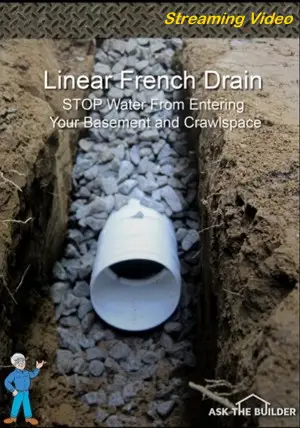Lots and Drainage
! ! ! See Author's Notes at Bottom of Column ! ! !
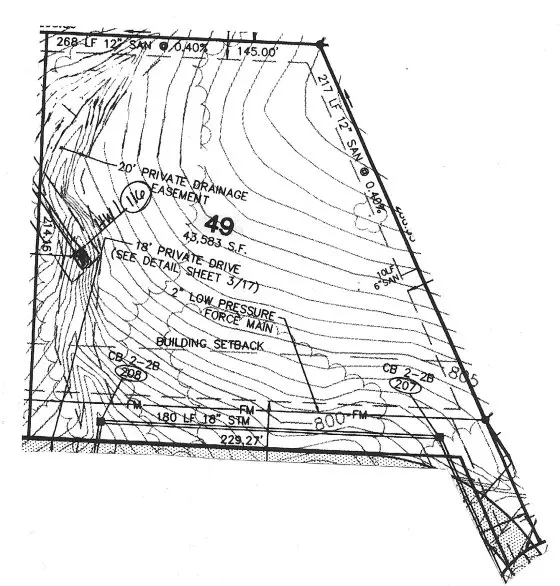
Learning to understand a topographic map that shows elevations will be worth the investment of time.
Drainage Problems
DEAR TIM: My husband and I are getting ready to purchase a lot for a new home. We are concerned about drainage and flooding issues. Our current home has a soggy lot and we would like to avoid that. What should you look for when selecting a lot for both a new and an existing home? Can you do anything to improve the drainage on a lot or to prevent house flooding? Can you look at a plan of the subdivision and tell a difference between lots? Jeeney A., Owensboro, KY
DEAR JEENEY: Drainage problems in and around homes can be a huge source of misery for a homeowner. Periodic flooding from storms, overland storm drainage and even subsurface water can cause damage to a home and its contents. If you choose wisely, you can sleep soundly every night a rain storm pops up. If you choose poorly, you may have many a sleepless night after your first flood.
Lot selection is just as important for people who live in flat coastal areas as it is for people who live in the plains and hilly areas. Each area has its own unique characteristics. The first thing you should be concerned with is the big picture. Take a look at the land around your lot. How much land is directly uphill from the lot? How much surface water is funneled onto or around your lot? You want to avoid lots that are in or adjacent to the bottom of natural drainage swales or shallow valleys. These are Mother Nature's gutters in a very heavy rainfall.
Pay attention to the regional location of your new lot. Is there a tremendous amount of land yet to be developed that may cause the streams around your home to carry more water in a future storm? Storm water retention basins are required in many new developments, however they end up discharging more water into streams and creeks than before the development was undertaken. Prior to development, undisturbed soil actually captures and soaks up a certain amount of rain water. After development, parking lots, driveways, streets, rooftops collect and disgorge this rainwater into the retention basins.
Build Your House Elevated
Consider picking a lot where the actual house location rises up above the surrounding land slightly. If your lot does not have this feature you can often create it artificially. The trick is to hold the top of the foundation or slab up out of the ground 18 to 24 inches and then use excavated foundation dirt to create a gentle grade away from the house in all directions. This slight rise in elevation in low lying areas may keep the inside of your house dry in a torrential rain storm while your neighbors are wading around in one or two inches of water in their slippers.
Try to look for a lot that has perhaps 3 or 4 feet of elevation difference over the entire lot. Lots that have this valuable asset allow you to install subsurface drainage pipes that can drain soggy lots or capture overland storm water that is aiming for your house. You can install a linear french drain or an inter-connect series of these simple drainage trenches to collect subsurface and overland water and then direct it to the low point on your lot.
How can a trench drain help?
These simple trench drains are often only 6 inches wide, 18 to 24 inches deep. You install a 4 inch perforated drainpipe at the bottom of the trench and then fill the trench with 1 inch diameter rounded washed gravel. Grass will eventually cover the top of the gravel to hide the trench. If you want to capture overland water, widen the trench as it nears the surface and create a walking path with flat stones that are surrounded by the washed gravel.
Many land developers sell lots using plans. These plans often contain lines that tell you what the lot topography will look like when all grading is complete. These lines connect points on the lot of equal elevation and are usually drawn in two foot increments. If the lot you are looking at has lots of lines on it that are closely spaced to one another, it means it is a hilly lot. Lines that are V shaped indicate a large or small valley that is present on the lot. If you don't understand the lines, take the plan to the actual lot and see how the actual land relates to the lines. It isn't really that hard to figure out once you see the land!
Author's Notes:
You may wonder if my advice is worth anything. Well, read what Jim Sanders wrote to me when he was at the end of his rope:
"Hi, I just wanted to write to give you the results of my "Trench Drain". I have had a wet crawlspace for 15 years. Water would fill the crawlspace at times, so we actually had to drill weep holes at the base so that it would enter the basement and eventually, the sump pump.
I have tried everything. Several contractors said that the only thing we could do was to bring the water into the house via drainage tile and let it enter the sump pump. That would work, but because I live on a 6' elevation, there is no reason that I should have water problems. It became like clockwork...when it rained, we would rush home from the lake or wherever we were vacationing so that we could be prepared to start the backup generator, in case the power failed. We even had our alarm company put a sump alarm on our system, so they could notify us if we had a power failure. Battery backup was not an option, because sometimes we lose power for days and during any rain, our sump would run every 7 minutes...just like clockwork.
I found your site and read the article on the trench or French drain. At first, it sounded a bit like "holistic healing" to me. I failed to understand why a 2 ft. deep trench, 4 ft. away from the house would do any good. How could this simple thing correct an extreme water problem that has plagued me for years, cracked my foundation, settled my garage floor and ruined almost every vacation?
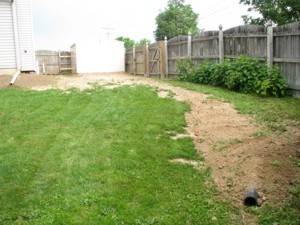
The Linear French Drain trench running from the house. PHOTO CREDIT: Jim Sanders
I decided "what the heck". I had to dig by hand using a trenching spade and a pick-ax, because the builder back-filled our property with brick and blacktop. It took quite a bit of time. Because the ground level varies so much on that side of the house, I was not able to achieve exactly 2 ft. deep. It varied from 18" to 30" in spots, but the slope was downhill. The trench is about 80 ft. long. At times, I thought about filling it all in, because I just didn’t believe that it would work.
I stoned it, put tile in, and filled it with #1 round stone. I socked the pipe just for safety measure and I also used geotextile fabric on top, so I could cover with dirt and grass. I also ordered some clay and pitched from the house to the drain.
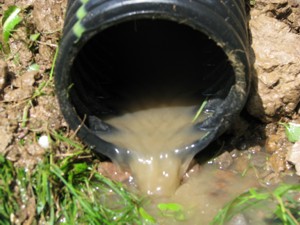
After a short rain, water is running away from the house. PHOTO CREDIT: Jim Sanders
Result? For the last month, we have had 7 or 8 torrential rains, the worst of which was last night. It rained so hard, that our lawn washed out in spots because of the high clay content. Our sump pump, that normally ran every 7 minutes during and after rain, has not turned on for 4 weeks. The silt at the bottom of the sump well is now dry and cracking. Our crawlspace has not shown a trace of water or even moisture.
Since I couldn’t see correcting the foundation cracks or the garage floor settling and tilting until I corrected the problem's source, I waited to see if the trench drain worked first.
This week, I had a company come in and perform sort of a "mud-jacking" technique on the garage floor, which worked perfectly. Also, during the past few weeks, I parged the cracks in the foundation.
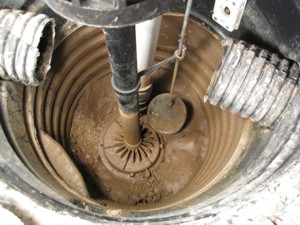
A dry sump pump. PHOTO CREDIT: Jim Sanders
I just wanted you to know how this worked. I stressed for many years over this issue and the solution was nowhere near as difficult as I thought it would be.
As a side note, I went to the end of the drain tile during a hard rain to see what was happening. Water was running out of the drain tile in about the same exact volume that it previously ran out of the weep holes in my crawlspace. This winter will be interesting, because last year, the ground next to the house was so saturated that during a thaw, my sump would run constantly. I'm guessing that the ground between the trench and the house will probably be drier now going into this winter."
- Jim Sanders, Upstate area - New York
CLICK HERE to get FREE & FAST BIDS from local drainage expert contractors.
Column 289
